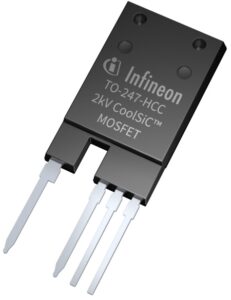 Infineon Technologies AG introduces new CoolSiC 2000 V MOSFETs in the TO-247PLUS-4-HCC package to meet designers' demand for higher power density without compromising system reliability, even under demanding high voltage and switching frequency conditions. CoolSiC MOSFETs offer a higher DC link voltage so that power can be increased without increasing current. It is the first discrete 2000V breakdown voltage silicon carbide device on the market and comes in a TO-247PLUS-4-HCC package with 14mm creepage distance and 5.4mm clearance distance. With low switching losses, the devices are ideal for solar systems (e.g. string inverters) as well as for energy storage systems and electric vehicle charging applications.
Infineon Technologies AG introduces new CoolSiC 2000 V MOSFETs in the TO-247PLUS-4-HCC package to meet designers' demand for higher power density without compromising system reliability, even under demanding high voltage and switching frequency conditions. CoolSiC MOSFETs offer a higher DC link voltage so that power can be increased without increasing current. It is the first discrete 2000V breakdown voltage silicon carbide device on the market and comes in a TO-247PLUS-4-HCC package with 14mm creepage distance and 5.4mm clearance distance. With low switching losses, the devices are ideal for solar systems (e.g. string inverters) as well as for energy storage systems and electric vehicle charging applications.
The CoolSiC MOSFET 2000 V product family is ideal for high DC link systems up to 1500 V DC . Compared to 1700 V SiC MOSFETs, the devices also provide a sufficiently high overvoltage margin for 1500 V DC systems. CoolSiC MOSFETs provide a reference gate threshold voltage of 4.5V and are equipped with a rugged body diode for difficult switching. Due to the .XT connection technology, the components offer first-class thermal performance. They are also highly resistant to moisture.
In addition to the 2000V CoolSiC MOSFETs, Infineon will soon release corresponding CoolSiC diodes: The first release will be the 2000V diode portfolio in the 4-pin TO-247PLUS package in Q3 2024, followed by the 2000V Diode Portfolio CoolSiC in TO-247-2 package in the last quarter of 2024. These diodes are particularly suitable for solar applications. A matching gate driver portfolio is also available.
The CoolSiC MOSFET 2000 V product family is now available. Furthermore, Infineon also offers a suitable evaluation board: the EVAL-COOLSIC-2KVHCC. Developers can use the board as an accurate universal test platform to evaluate all 2000V CoolSiC MOSFETs and diodes and the EiceDRIVER Compact Single Channel Isolated Gate Driver 1ED31xx family of products via double-pulse or continuous PWM operation.

